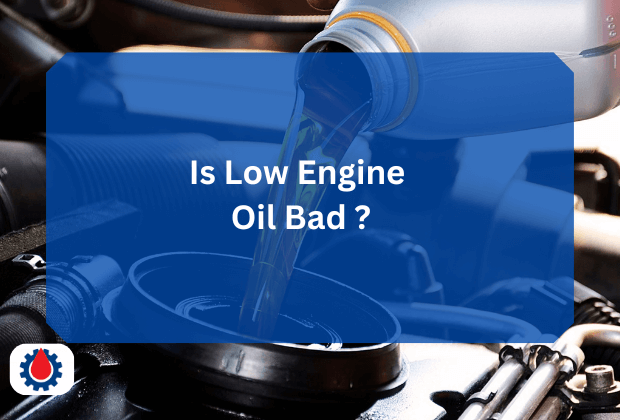What happens when engine oil levels drop too low? Is low engine oil really that bad? In this post, we’ll explore why maintaining proper oil levels is crucial, the risks of low engine oil, and how to prevent costly damage to your vehicle.
Is Low Engine Oil Bad
Low engine oil is extremely harmful to your vehicle, as it leads to increased friction, overheating, and accelerated wear on engine components.
Without sufficient oil, critical functions like lubrication, cooling, and cleaning are compromised, potentially causing sluggish performance, sludge buildup, or even catastrophic engine failure.
Related Can Low Oil Cause Check Engine Light(Explained)
The Dangers of Low Engine Oil
Running your car with low engine oil is like running a marathon without water, it’s only a matter of time before something gives out.
Here are the primary risks associated with low oil levels:
1. Increased Friction and Wear
Without enough oil to lubricate moving parts, metal components like pistons, bearings, and camshafts grind against each other. This increased friction accelerates wear, leading to premature component failure. Over time, this can result in costly repairs, such as replacing worn bearings or even the entire engine.
2. Overheating
Engine oil absorbs and dissipates heat generated during combustion. Low oil levels mean less heat is carried away, causing the engine to run hotter than normal. Overheating can warp engine components, blow head gaskets, or cause the engine to seize entirely, a repair that could cost thousands of dollars.
Related Overfilled Engine Oil by 1 Litre(5 Things To Do)
3. Reduced Engine Performance
Low oil levels can lead to poor engine performance, including sluggish acceleration, reduced fuel efficiency, and rough idling. This happens because the engine has to work harder to compensate for inadequate lubrication and cooling, straining its components.
4. Sludge and Contaminant Buildup
Oil also cleans the engine by suspending dirt and debris. When oil levels are low, the remaining oil becomes dirtier faster, forming sludge that clogs engine passages. This can restrict oil flow, exacerbating wear and reducing engine efficiency.
Related Is Low Engine Oil the Same as an Oil Change(Explained)
5. Catastrophic Engine Failure
In extreme cases, running an engine with critically low oil can lead to total engine failure. Without lubrication, parts can seize, causing the engine to lock up. This is often irreparable, requiring a full engine replacement, a repair that can cost more than the vehicle’s value in some cases.
Related Engine Overheating After Oil Change(6 Causes + Solutions)
Signs Your Engine Oil Is Low
Modern vehicles are equipped with warning systems, but it’s important to recognize the signs of low engine oil before serious damage occurs. Watch for these indicators:
- Oil Warning Light: A dashboard light shaped like an oil can or a warning message indicating low oil pressure.
- Unusual Engine Noises: Knocking, ticking, or grinding sounds, as parts rub without proper lubrication.
- Burning Smell: Overheated oil or burning metal from excessive friction.
- Poor Performance: Sluggish acceleration, reduced power, or difficulty starting the engine.
- Visible Leaks: Puddles of oil under your car, indicating a leak that’s reducing oil levels.
Related Low Engine Oil Pressure(8 Common Causes & Solutions)
Preventing Low Engine Oil Problems
The good news is that low engine oil is entirely preventable with regular maintenance and vigilance. Here are some practical steps to keep your engine well-lubricated:
1. Check Oil Levels Regularly
Use your vehicle’s dipstick to check oil levels at least once a month or before long trips. Ensure the car is on level ground and the engine is cool. If the oil level is below the “minimum” mark, top it up with the manufacturer-recommended oil type.
2. Follow the Maintenance Schedule
Adhere to your vehicle’s recommended oil change intervals, typically every 5,000 to 7,500 miles for conventional oil or 10,000 miles for synthetic oil. Regular oil changes ensure fresh, clean oil is always circulating.
3. Address Leaks Promptly
If you notice oil spots under your car or a rapid drop in oil levels, have a mechanic inspect for leaks. Common culprits include worn gaskets, seals, or a damaged oil pan.
Related Does Service Engine Soon Mean Oil Change(Explained)
4. Use the Right Oil
Always use the oil grade and viscosity recommended by your vehicle’s manufacturer. Using the wrong oil can reduce its effectiveness and harm the engine.
5. Monitor Driving Conditions
Frequent short trips, extreme temperatures, or towing heavy loads can cause oil to degrade faster. Adjust your maintenance schedule accordingly if you drive under severe conditions.
Final words
Is low engine oil bad? Absolutely. It’s a silent threat that can lead to increased wear, overheating, and even catastrophic engine failure if ignored. Regularly check your oil, stick to your maintenance schedule, and address any warning signs promptly.




